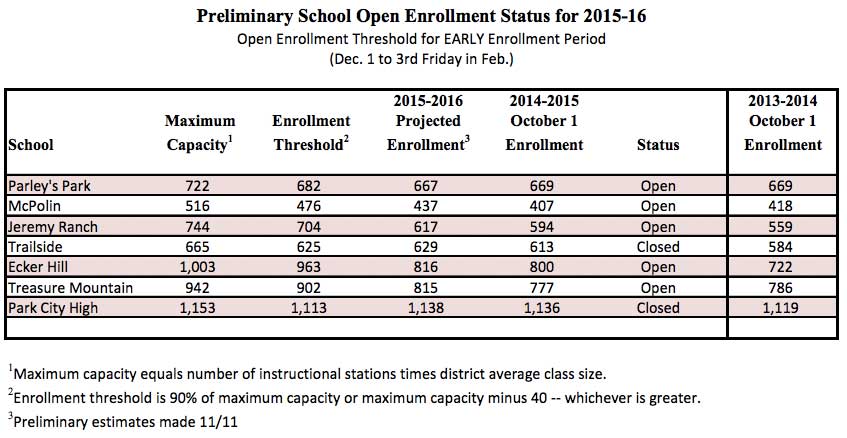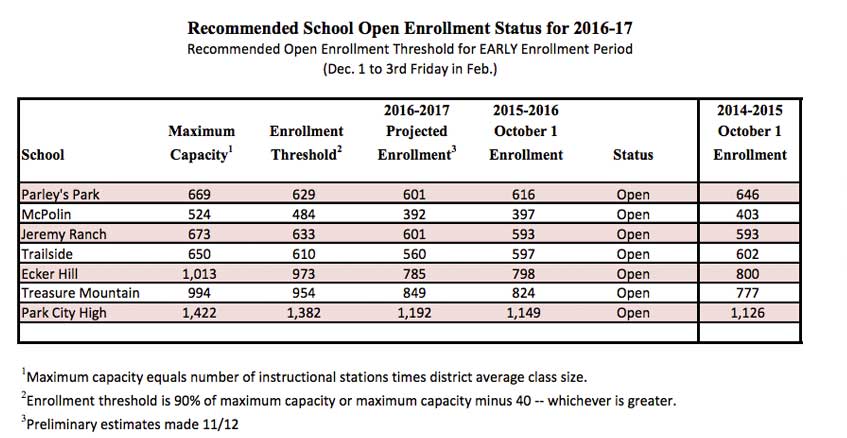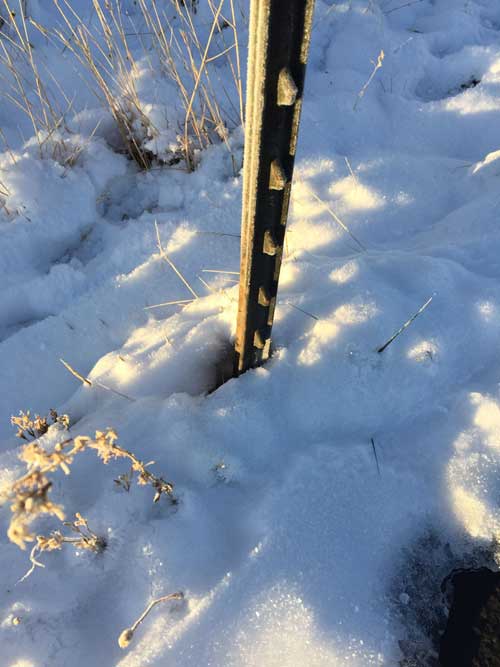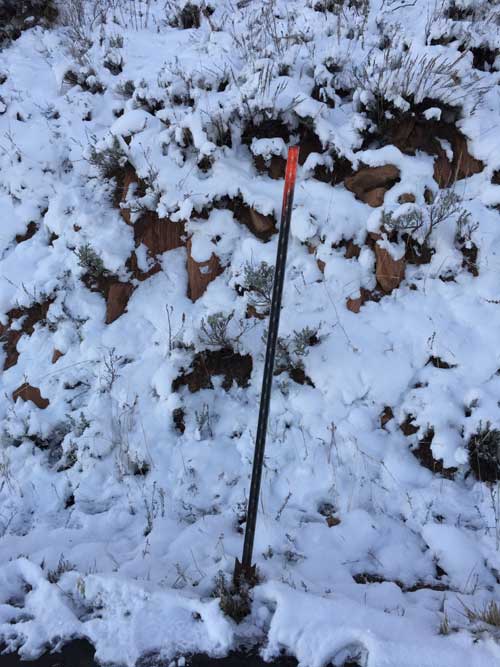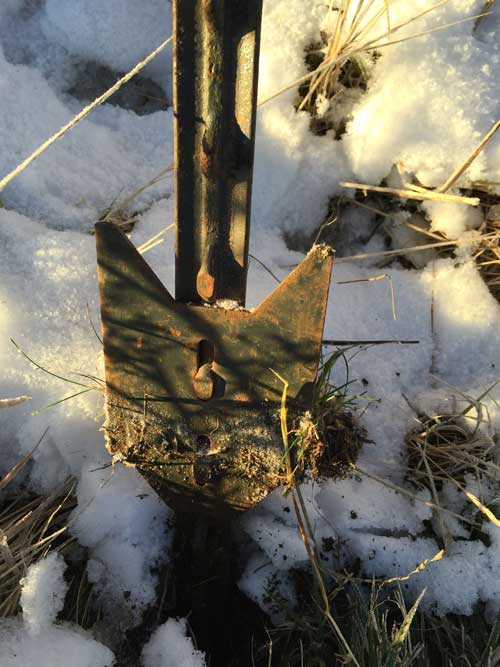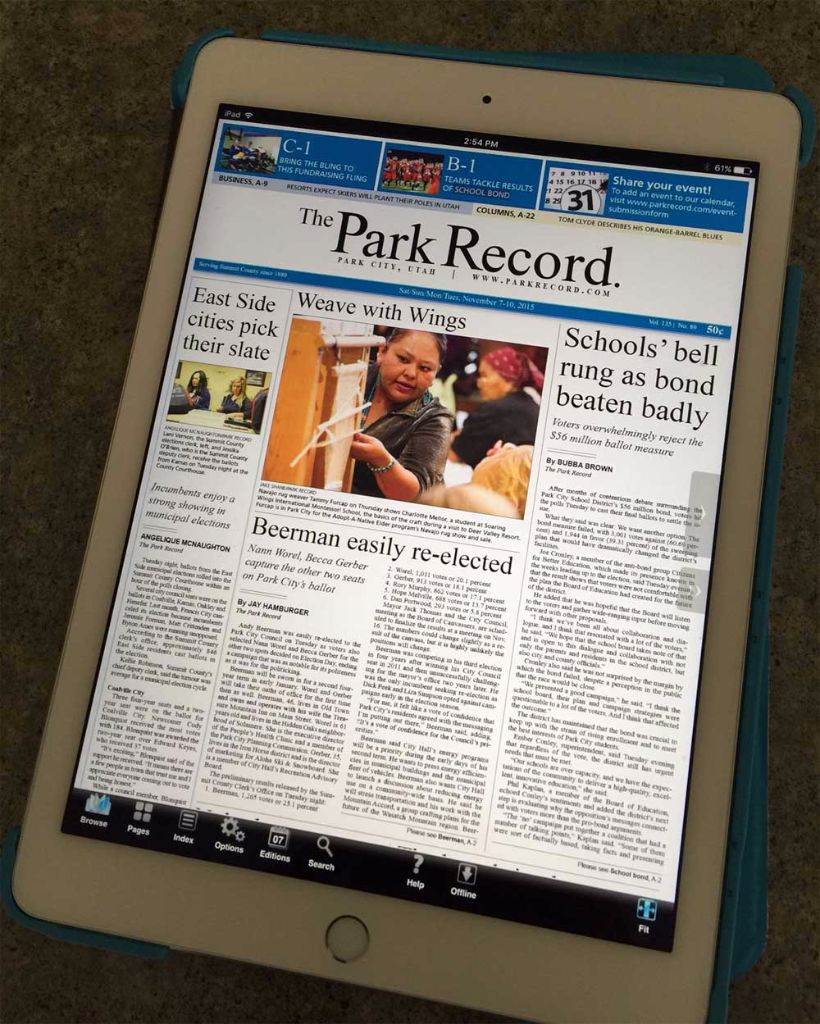School Board Still Needs to Work on Regaining the Community’s Trust
In the wake of the school bond defeat in early November, some of the school board members have done an admirable job meeting with the public to understand why people were against the bond. This is a very encouraging sign that hopefully the relationship between the board and the public won’t be adversarial going forward.
Yet, every once in a while something pops up and still makes me shake my head. If you recall, one of the chief school board arguments for needing the bond was because our schools were at capacity. Board members and district personnel often presented this chart to the public to demonstrate capacity:
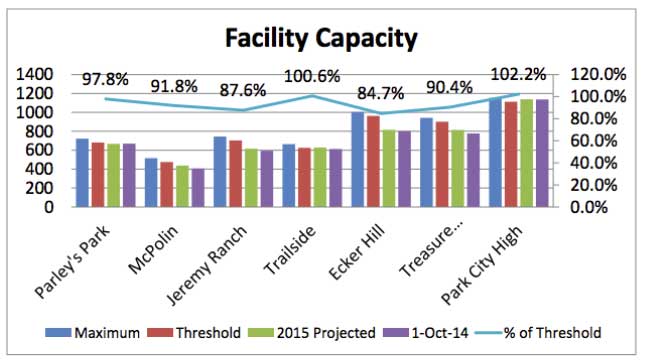
I believe this chart was generally driven by open enrollment number calculated by the school district. Here are the Open Enrollment numbers for 2015-2016:
The high school and Trailside were closed, which means out of district students weren’t generally eligible to enroll at those schools. Keep in mind that the argument of “full schools” was being made up until election day. A few days after the election, the 2015-2016 open enrollment numbers were released:
You may now notice that the high school’s capacity has increased by 23%. You may notice that Parley’s Park’s maximum capacity increased by 8%. You’ll also see that capacity went down at some of the schools. The issue is that a few weeks ago we were being sold that our schools were full. Today we find that, at least per this estimate, that our schools aren’t going to be full.
I’m not arguing that there is some grand conspiracy to inflate and deflate numbers. After all, these numbers are driven by state of Utah formulas. According to School District representatives, changes to capacity at the high school are influenced by renovations that are occurring there. Capacity at our elementary schools are influenced the reading program being brought back into the classrooms (and out of dedicated rooms). So, there is a method to the madness.
Unfortunately, we as voters were told by the district that the schools were full. However, we weren’t told that other crucial piece of information before the election… that in about 10 days they wouldn’t be “full” anymore. School board member Julie Eihausen, during a recent school board meeting on the topic, said what I’m sure many people were thinking. She said, “I’m trying to wrap my head around how we went from 5 of 7 schools at capacity to having none.” The answer from the district Business Administrator, Todd Hauber, was that there were additional instructional spaces now and that the average class sizes had changed.
Yet, for me it’s still a matter of trust. Wasn’t the fact that our schools weren’t going to be full known before the election? If they weren’t going to be full and the district knew it, why wasn’t this told to the public? It’s like your child telling you their school day was good, but leaving out that crucial part about getting detention. Going forward, there’s a lack of trust that now will require extra vigilance.
It’s the same here. When the school district goes for their next bond (likely in 2016) and says anything about their enrollment numbers, how do we know we can trust it? While before we took them at their word, now someone will need to stand up and ask: “That high school capacity number what’s it based on? When was that calculation done? What’s changed since that number was created? Will anything else be changing that’s driving these numbers? Are these capacity numbers what a lay person would consider real capacity? When was your last projection for student numbers? How has that changed since then…etc…etc…etc…”
I suppose it’s not just these numbers that should be carefully vetted by the public. Any estimates done on timelines, construction costs, or needs likely should be carefully analyzed. For instance, I think most people believe that Treasure Mountain Junior High should be torn down. I didn’t start with that opinion, but I probably agree now. However, my agreement is largely based on the fact that there were 3 studies done that showed the costs required to maintain the building were in the $20 million range (almost as much as a new school). Yet, now I want to look at those studies. I want those to be passed by someone in our community with the knowledge to confirm that THE REQUIRED REPAIRS will cost almost as much as new school, so we might as well spend our money wisely. Perhaps the studies were all done in the right way. Perhaps, the costs estimates were only for the things that we HAD to have. Perhaps the studies’ findings were black and white and there could be no other argument other than to tear down the school.
But perhaps they weren’t.
That’s the problem with trust. Once it’s questioned, you start looking at everything (whether there is something there or not). As they say, fool me once — shame on you…fool me twice — shame on me.
It’s a great thing that the school board is working with the public to understand the pieces of the bond that the public doesn’t like. Yet, as the district gears up for the next bond, things need to be different the next time. Fair or not, the school district was already living in the shadow of cost overruns for the last renovations done to the high school. They were living in the shadow of running out of money in some of their funds, thus causing taxes to be raised. Now they are living under the shadow of how they used and presented capacity numbers.
At some point, that shadow’s going to be so dark, it’s going to be really hard to find their way out.
Enjoy this Winter Because the Next Couple May Not Be So Good
It looks like we have a great chance of having a big snow fall this year, if you believe in the effects of the El Nino. The phrase El Nino means, “an irregularly occurring and complex series of climatic changes affecting the equatorial Pacific region and beyond every few years, characterized by the appearance of unusually warm, nutrient-poor water off northern Peru and Ecuador, typically in late December.” To most people in the Western U.S. it means that we have a good chance of a lot of snow this winter.
As of now, the El Nino effect in the Pacific is the strongest it has ever been. Temperatures are 3 degrees Celsius higher than normal in the ocean. The previous record was in November 1997, with temperatures being 2.8 degrees Celsius higher than normal. In that 1997-1998 ski year Alta had about 600 inches of snow, which wouldn’t be described as ming blowing, but it was above average.
Yet what is important is what happened in the years after. In 1998-1999 Alta had 470 inches, which is below average. In 1999-2000 Alta had 500 inches, again below normal. In 2000-2001 Alta had 470 inches of snow. By 2001-2002, Alta was back over 500 inches. It seems that what often follows a rapid rise in ocean temperatures (El Nino) is a rapid decrease in ocean temperatures (La Nina). That is shown in this chart:
The truth is that an El Nino isn’t going to guarantee us a blow out winter. However, if you believe in El Nino, should probably believe in what comes after… And that doesn’t look good.
So, the Park Rag’s advice is to live this winter like there’s no tomorrow. Of course, there will be a tomorrow. It just may be four years away.
PSA: Beware Your Pet’s Paws as the Snow Starts to Fly
Looks like it’s a PSA Friday…
One of the changes I’ve noticed this year is the increase in number of trail markers alongside trails around Park City. My assumption is that Basin Rec has added markers so that paved trails can be plowed more effectively for winter use. It’s a great idea.
However, it appears to that they often aren’t pushing the markers down into the ground far enough. This leaves two points that stick out of the ground. Right now you will be able to see them and avoid them, however, once snow lightly covers the markers they will be hidden. The problem is if your pet steps on the snow above the point, and their foot sinks down, they will likely slice open their paw.
These points don’t seem to be sharp enough to go through a snow boot, so it’s likely that people aren’t at too much risk. However, as the snow comes, and you are out on the trails, you probably want to keep your pets away from these trail markers (just in case).
PSA: Be Aware of Your Shipping Options This Holiday Season
A friend contacted us yesterday with a warning: understand your shipping options or be prepared to be ripped off. It seems she was trying to ship children’s clothes that no longer fit across the country to a relative. She took her box to the post office in Kimball Junction and told the worker that she needed to ship the box and didn’t really care how long it took. The post office worker replied that given the box’s size, priority shipping was the only option. Two points of clarification are needed. First, priority means 2-3 days shipping to most locations. Second, she said this was not a “huge” box; in fact she’d received a shipment from Amazon in it the day before.
The price to ship the box across 4 states via priority mail was almost $37. At that price, she balked and was ready to walk out. She asked, “isn’t there another option?”. The worker finally replied that it could go Standard Post, but that would be via “ground shipping”, and cost $22. My friend replied that she had initially said that time didn’t matter, so of course she was OK saving 50% if it took a bit longer. The worker replied: OK.
In visiting with her, she felt she was being lied to in order for the post office to make an extra buck — something she didn’t expect from the post office. She said it was almost like someone had been encouraging them to up-sell in order to increase their revenues.
So the moral of the story is (as with most things) … do your own research. If you really can wait 7-10 days for a package to arrive make sure you are prepared to demand that level of service. If you can wait and don’t demand it, you may be paying more than you need to.
The Fight For Our Moose
If you’ve lived in the area for even a short period, there is likely one wild animal you’ve seen roaming our hills. The majestic moose. These giant creatures, for the most part, only cause harm to our trees. Due to their size and the fact that they are indeed wild animals, they do occasionally hurt people and their canine companions, but that is a rare event. Unfortunately, these animals are coming under attack from an unlikely source. Us.
It seems that some residents across the area have started calling Utah’s Department of Wildlife Resources (DWR), because they are fearful of what the animals might do to their children, property, or animals. The DWR then often shows up and “transplants” the moose to another area. The resident goes on blissfully unaware and is generally happy that the moose has been “relocated to “greener pastures.” What they don’t realize is that they are issuing a death sentence for the poor animal.
According to the local wildlife preservation group, Save People Save Wildlife, of the 320 moose that have been transplanted within Utah, 280 of them have died, in at least part part, due to their relocation. That is a survival rate of only 12.5%, or put another way, 87% of transplanted moose don’t make it. A number of factors could contribute to this outcome; however a Utah Department of Natural Resources document says that they don’t have a definitive answer of why transplants don’t work here. Some people speculate that since moose live most of their lives in a 10 mile radius, being transplanted out of an area causes too much trauma.
While the near-certain-death of transplanted moose is obviously the largest concern, we also have to consider what transplanting moose will mean for the character of the Park City area. If the statistic about moose living their lives in a ten mile radius is valid at all, when a moose is moved from the Park City area, that moose is not coming back. That moose is not having calves. At some point the population will dwindle, the moose will be gone, and we will be missing a very special part of our community.
Many residents of Jeremy Ranch, an area that has seen many moose relocated this year, are taking matters into their own hands. On local message boards they are imploring people to not share where and when they see moose. Instead they text their immediate neighbors to give them a heads up that a moose is in area, so they can ensure the safety of their children and pets. Members of the community are also saying that the Department of Wildlife Resources may be violating Utah State Code by not following specific measures required by law when transplanting big game. They are approaching the Executive Director of the DWR to ensure they are aware of actions being taken by their employees and to share the public’s concerns.
While moose can be dangerous, especially in the fall and when the mothers have young calves, most of us have learned how co-exist with them without problems. After all, they were here first. And as I often tell my 3 year old after we see a moose… “We are pretty darn lucky. There aren’t too many people that get to see a moose as often as we do.”
I believe most of us view ourselves as stewards of this great area we live in. We take pride in it. We enjoy the wildlife. We appreciate that we aren’t living in Sandy. I think sometimes we just forget that we also owe this land something in return. In this case, we owe it to the moose, to find a way to continue living together. We need to ensure that this is a place that those majestic animals can continue to call their own. If we lose them, this place won’t quite seem like home anymore.
Below is a ABC 4 segment on the issue…
h/t to Walter for suggesting this as a topic
The School Board Needs a Reboot (not a script rewrite). They Need to Pull It Apart and Put it Back Together.
When a TV series or movie is being resurrected from the dead like Battlestar Galactica or Dallas, there are generally two options. You can start it fresh with new ideas and out of the box thinking or you can simply tinker with the script. The cheap way out is the latter option, but the more successful path is usually to rethink the concept. From reading a recent Park Record article on the school board’s response to their bond defeat, it seems they may be only tinkering with the script.
The school board has stated it wants to understand why its $56 million bond proposal was defeated. According to board member Phil Kaplan, “The voters sent a message, and what that message is, isn’t clear.”
What’s clear is that the stunning defeat of the bond has left the board off balance.
The school board’s answer to trying to understand “the why” appears to be a voter survey. The problem with a survey is that they are notoriously hard to get right. First, the questions have to be crafted by professionals, in an unbiased way. Second, the survey has to be distributed in a representative way. Third, it’s not a quick process. I look at the “state of the county” survey that Summit County sends out to residents every couple of years. If I recall correctly, it is crafted by a university professor who has experience in asking the right questions in order to get valid results. Second it is mailed out to a couple thousand Summit County residents that have been deemed representative. Third, the process takes months and costs thousands of dollars.
If the school board decides to go down the survey route but doesn’t follow a similar process to the county, they are going to be using the same strategies that led them their disastrous bond outcome. If they make up the questions themselves, they will be subject to their own biases. If surveys aren’t distributed representatively, the data won’t be valid. If they demand an answer tomorrow, the answer they get will be wrong.
The other issue with a survey is that they will get lots of data points but probably miss the forest for the trees. One of the unexpected benefits of doing something like the Park Rag, is that I have learned to take criticism and hopefully become a better person because of it. I’ve been called an idiot. I’ve been laughed at. I’ve had my ideas torn part. People call some of my articles half baked. People say I don’t understand. People correct me all the time…. and I’ve learned to love the commentary and grow from it. Ultimately, it makes a better product. That is the same lesson that the school board needs to learn. Humility.
If I were the school board, and I decided to ask a survey on why the bond failed, I would include (among other questions) the following:
- On a scale of 1 to 10, how much do you trust the school board?
- If we engage in a $50 million bond effort to rebuild schools, do you trust the school board to spend your tax dollars wisely? Yes or No.
- In 2015 bond election, do you think the school board solicited enough public input? Yes or No.
Only through asking questions that can lead to harsh realities do we typically understand how we are truly perceived. Only from truly understanding how we are perceived, can we begin to lead.
What would I recommend that the school board do?
Begin by going on a listening tour. Talk to the people you hate right now. Be more like Tip O’neil and Ronald Reagan than like John Boehner and Barack Obama. Understand why the Citizens for Better Education opposed your viewpoints (and truly listen this time). Talk to the teachers and see why many of them voted against you. Hold town halls where you let people talk in an open ended format. Sit there, listen, and take it. Be tablarasa. Become better because of it.
My fear is that the school board seems to hold a view that they are undoubtedly right on all accounts and anyone who opposes them just doesn’t understand. In many ways listening to the school board feels like I am listening to Rush Limbaugh. When school board member Phil Kaplan says, “Does anybody not believe Park City is going to keep growing?,” trying to explain why we need the board’s plan… I say “Actually enrollment dropped in the schools this year by 0.5%. A lot of Park City’s growth is from second home owners who don’t have kids. Most parents of school aged children can’t afford a $800,000 house. Why do you conflate population growth with enrollment growth?”
As stated before I would like the school board to begin by talking to those who opposed them in order to get historical context for why their ideas failed.I would then like to see our community (including the school board) agree on two or three core issues we would like to solve. After that, town hall discussions, with no preconceived notions, should be held where people could talk about solving those issues. I would then like the outcome of those town hall meetings to drive options. I would like those options then presented back to the community where further discussions took place. Then I would like the school board to ultimately weigh all the information and decide on a course of action.
The Park City School Board should be more a judge of ideas than advocates.
Instead, what we had was the school board Master Planning Committee, made up of school board members, school administrator, teachers, school district staff, and two members of the public, talk for months in an echo chamber before the public was even engaged. Then when the public was engaged, it was handled like a Choose Your Own Adventure book with the predetermined path highlighted.
We have a great opportunity ahead of us. We are in a community that both values education and generally has the means to achieve it. We have well educated and experienced people everywhere, from our local business persons, to our civil servants, to those retired, to the lifty who would rather be reading Voltaire. We just need to take advantage of that natural resource.
I truly hope the school board will take another step back, scrap the survey idea, take a few more weeks off to clear their heads, meet with those opposed to the bond over coffee and/or beer, and start afresh with the community.
I really hope they find it in their hearts to pull it apart and put it back together.
What the School Bond Vote Can Teach Us
We, held the day
In the palm
Of our hands
They, ruled the night
And the night
Seemed to last
As long as six weeks…
– Goodnight Saigon, Billy Joel
One of the ways the Park City School Board failed in their attempt to pass a bond was in communication. This failure wasn’t due to lack of trying but perhaps more-so due to lack of imagination. The school board hired a communication expert (Panic Button Media) who did what experts have done in the past. They coordinated pieces to go into the Park Record. They coordinated appearances on KPCW. They word-smithed language to be disseminated. Yet, for whatever reason it just wasn’t enough.
If this was the Vietnam War, the Park City School Board would be the United States. Those in opposition to the bond instead fought a guerilla war.
The powers that be trotted out all the standard maneuvers. They had media appearances. They met with the Parent Teacher Organizations. Their supporters included influential members of the Park City Educational Foundation. They did what you are supposed to do when you are in command and control.
The opposition employed a different strategy. They went grass roots. Their weapons of choice were email lists. They utilized neighborhood websites like NextDoor. They attacked using Facebook. Perhaps more importantly, they were hyperlocal. If the bond passes, what will traffic be like at Ecker Hill? Shouldn’t we keep our middle school in Park City proper? Why are we investing in athletics when we should be investing in our child’s education? They won the hearts and minds.
Sure, the “soldiers” for the school district arrived at the village and tried to convince the people that they were right. However, when the soldiers left, the opposition’s message continued to resonate. In the end, the people said they couldn’t support those in charge and voted overwhelmingly to ask for another path.
I believe this is perhaps a wakeup call for the powers that be. Over the next few years, our local governments will be asking for another school bond. They’ll be asking more money for transportation. They’ll likely be asking for money for another field house. Unfortunately, the tried and true methods have shown that they crumble in the face of even a modest opposing force. And make no mistake, the victory over the School Board have emboldened the opposition on many fronts.
It will be interesting to see if new methods can be devised to truly win the hearts and minds of our community or whether the same-old-same-old will be trotted out in the hopes that it will work one more time.
I hope that the powers that be now understand that early communication, with complete open minds, is the only way to truly succeed.
Why You May Want to Consider the Park Record E-Edition
A couple of months ago I wrote about blocking ads using an iPhone and ad blocking’s impact on the Park Record. Since that time, I have been using iPhone ad blocking software and it makes the experience of browsing the Park Record on a mobile phone much better.
At the time, I mentioned subscribing to the Park Record in order to continue supporting the paper. After all, they need eat. This past week, I finally put my money where my mouth was and subscribed to the E-Edition of the Park Record. I didn’t like the sustainability issues with receiving a physical paper twice a week, so I went purely with the electronic version ($48 per year) and couldn’t be happier.
You can sign up for the E-Edition completely online here. The process is a little confusing but you begin by creating an account and then you add a subscription to that account. Once you provide your credit card details, you have immediate access to the last few months of papers. Better yet, you get the paper in its entirety. Every section seems to look identical to the paper version of the periodical. Finally, for those people who like to go back and search for specific topics, it seems to be completely searchable.
You can read the paper on a computer, tablet, or e-reader. I’ve tried on the a computer and an iPad. I’d say the best experience I’ve found is on an iPad or Surface Pro tablet. The portrait view available on these devices feels the most like a real paper to me. As for usability, it’s not quite as nice as having a physical paper you can lay out on the table and scan; however, it is pretty close. You can view a whole page at a time and pinch and zoom to read the page. If your eyesight isn’t quite as sharp as it once was, you can click the article, ad, etc. and it will take you to a zoomed in view, which is always easy to read.
All in all, I couldn’t be happier with my decision to spend $50 a year. If you are looking for a way to read the paper but don’t like the idea of killing trees, you may want to give it a try.
The Rise of the Citizen (Again)
Things are changing around Park City and the citizen is at its heart. Across the city and basin, citizen groups are popping up. Citizens for Better Education successfully challenged the school board’s bond. Save People Save Wildlife is a Facebook community dedicated to getting wildlife fencing throughout the city. A resident from Jeremy Ranch, Alex Brown, has started a campaign to remove fees associated with busing kids who live “too close” to schools (and also get more kids on buses). Resident, Jennifer Terry, has long been fighting for a passage way across I-80 between the Pinebrook and Jeremy Ranch side, and recently her efforts have led to a small victory with a raised sidewalk being constructed under I-80. I’m sure there are more efforts under way that I’m not aware of.
While there have been citizens groups in the past like CAGE (Citizens for the Alignment of Growth and Environment) in the mid 2000’s and Citizens Allied for Responsible Growth in the 1990’s, the rise of these new groups represents a new phase in public engagement. Using tools like Facebook, Nextdoor.com, and email lists these groups are impacting local politics through alerting citizens to issues that may concern them. Because these efforts are both local and online, it enables these groups to build large followings that attend meetings, vote in elections, and educate public officials on their positions. They are also succeeding in disrupting the status quo.
With the recent successes, we shouldn’t be surprised if even more groups appear over the next few years. Their strategy is almost perfect. Issues come to the forefront that they care deeply about it. Social media is used to find like minded people and educate others. They then band together to try and influence political bodies toward their goals. If that doesn’t work, they don’t mind fighting in the court of public opinion during an election.
While power still does truly reside in our elected officials, the city and county governments, and local boards, the citizens impact is truly being felt. While I’m sure that none of us agree with every effort being lodged, it’s great to have such a diverse group of people, that may not have been involved in local government before, getting involved. Even more, it’s great that they are seeing success. This will likely ensure that they will keep involved.
This Has to Be Said
Sometimes you choose to write because you are excited about a topic and want to scream about it at the top of your lungs. This isn’t one of those times…
We are now a few days out from our School Bond Election. The public voted and the bond was rejected. Yet, what were we voting for? What were we voting against? Judging from the outcome, it appears most people were voting on the ideas inherent in the process. In this case, the ideas were struck down.
However, I think back to the days and weeks preceding the election, and many prominent people in our community told us that we weren’t voting on the idea, we were voting on HOW TO PAY FOR THE IDEA. “Do you want to pay for schools via bond or via tax?” was the cry. “Either way the school board is going forward with their plan.” Now three days on, I haven’t heard anyone in power (i.e., the school board) say they are going to go forward and levy a tax (perhaps it’s still coming). That lack of action just provides fodder for those who said a tax was just a threat designed to push people toward voting for the bond.
The problem is, that what seems now was just an idle threat, was propagated by some of the most prominent members of our community as fact. Some of these people were even elected officials.
More importantly, if it turns out to have just been a threat, it seems like a tactic designed to, at best, mislead people and, at worst, coerce people.
Most importantly, for those who said that, how do we have trust in what you say going forward?
This bond was one of the defining moments of the next decade and those who said we were simply voting on “how to pay for it” appear to be have been wrong, duped themselves, or were flat-out lying. Regardless, we can’t let that action get shoved under the carpet, never to be heard again. One just can’t say those things and hope no one remembers it when the tide goes against him or her.
I almost wish the school board would go through with it and levy their $500 a household tax for the next three years. At least then they would be putting OUR money where THEIR mouth was. At least then I would know that they were going to do what they said they were going to do. At least then I could look at many of community leaders and think they actually knew what they were talking about.
Instead, it appears that it was just words. Words designed to try and influence the outcome of an election. Words designed to manipulate our residents. Words that ultimately may have backfired.
If the school board doesn’t ultimately carry through with those words, many of us will never look at some of the people who emphatically uttered that phrase the same ever again.
And that’s really unfortunate.

